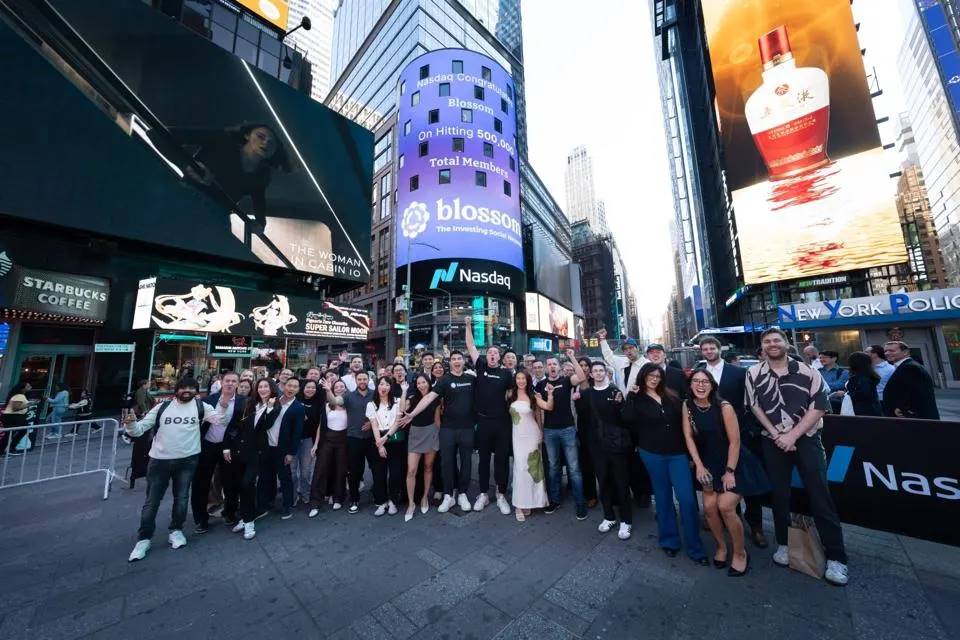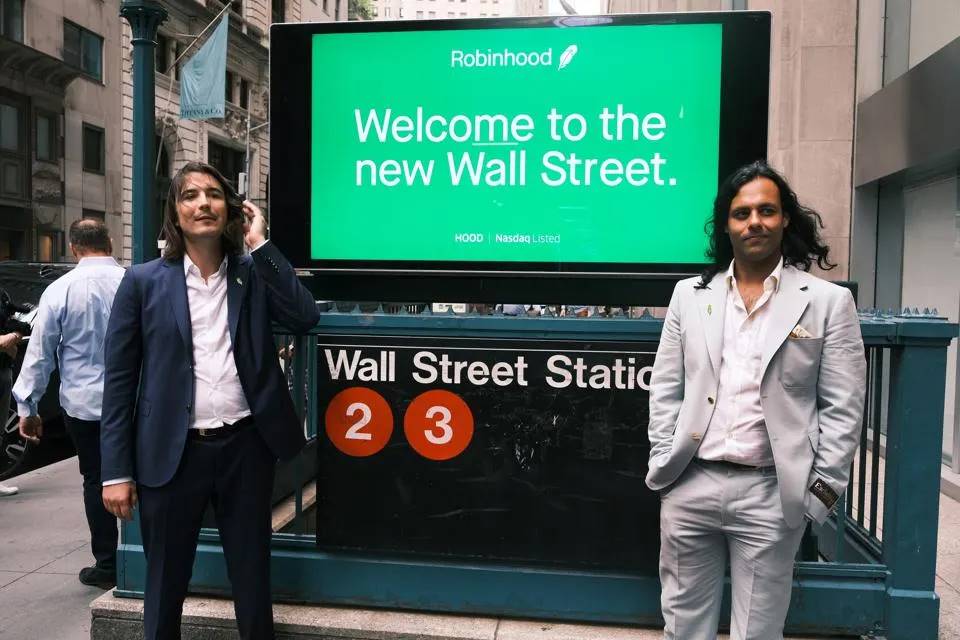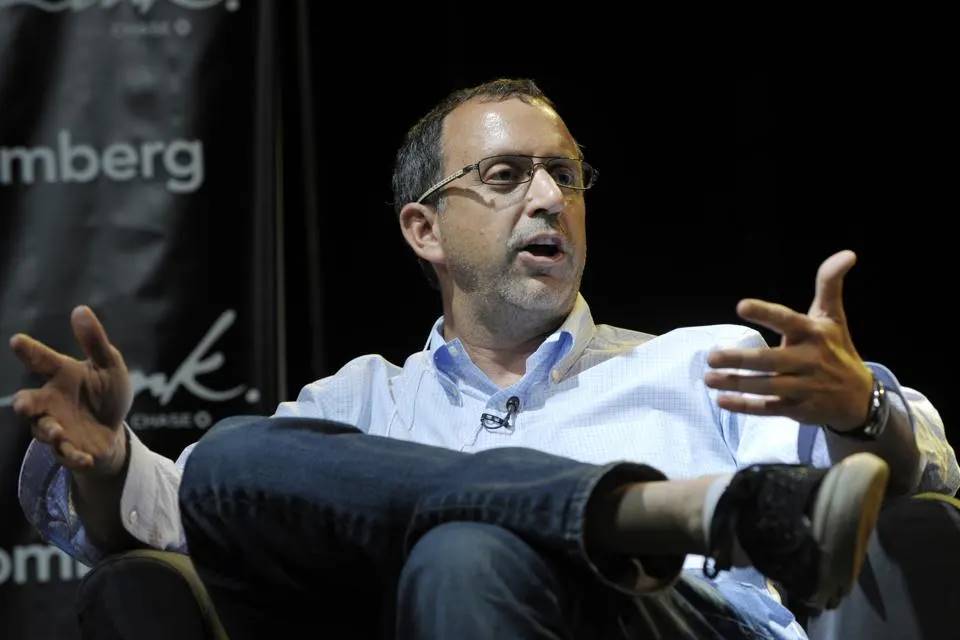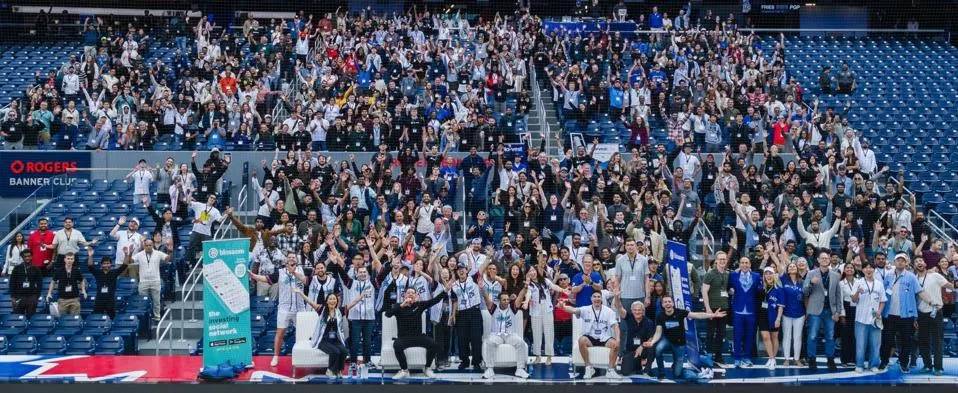Building this layer of infrastructure, the platform is creating a permanent market structure for the way retail investors operate.
Author: Boaz Sobrado
Translation: Deep Tide TechFlow

On January 23, 2025, Achi, the dog from the famous "Dogwifhat" meme, appeared at the opening bell ceremony of the New York Stock Exchange (NYSE).
Dogwifhat (token code: WIF) is a dog-themed meme coin based on the Solana blockchain, launched in November 2023, with its mascot being a Shiba Inu wearing a knitted hat.
Image source: TIMOTHY A. CLARY / AFP, provided by TIMOTHY A. CLARY/AFP via Getty Images
When Benchmark led a $17 million Series A funding round for Fomo in November 2025, this Silicon Valley's most selective venture capital firm made an unusual bet in the crypto space. Benchmark rarely invests in cryptocurrency startups. Although the firm supported Chainalysis in 2018 and a few other crypto companies, the crypto sector is not typically part of its investment portfolio. However, partner Chetan Puttagunta chose to join Fomo's board. Fomo is a consumer application that supports trading millions of crypto tokens across multiple blockchains.
Benchmark's investment is not just another trading application. They are betting on the rapidly emerging field of "social trading infrastructure," which is becoming an indispensable tool for retail investors, just like brokerage services.
Not Just Speculators: A Case Study of Blossom Social

The Blossom Social team poses with community members in front of Nasdaq.
Image source: Blossom Social
Maxwell Nicholson, CEO of Blossom, has a deeper understanding of "user friction" than most. When you create a social platform and require users to link their brokerage accounts during registration, it undoubtedly creates a significant barrier early in the user journey. Most consumer companies would choose to remove such a hurdle, but Blossom made it a mandatory requirement.
This decision seems counterintuitive until you understand Nicholson's vision. Blossom launched in 2021 during the retail trading frenzy sparked by GameStop. At that time, discussions about stocks on Reddit were completely anonymous; you couldn't see real holdings, only various claims and statements. While StockTwits had already amassed a large user base, most users shared only unverified personal opinions.
Nicholson aimed to build a social network based on real investments, a goal achieved through the recently launched API (like SnapTrade) that validates brokerage account connections. The technology is mature; the question is whether users can accept this "friction."
It turns out they can. Today, Blossom has 500,000 registered users, with about 100,000 having linked their brokerage accounts, managing nearly $4 billion in assets. On Blossom, half of the assets held by users are ETFs (exchange-traded funds), rather than individual stocks. The most popular holding is the S&P 500 ETF.
The requirement to link brokerage accounts ultimately shaped Blossom's community culture. Nicholson observed that StockTwits later introduced brokerage account linking as an optional feature. Although services like Plaid or SnapTrade provided technical support, StockTwits users did not widely adopt this feature because linking was not part of the platform's core DNA. In contrast, almost all regularly posting users on Blossom share their real holdings and earn a special badge through verification. This culture was formed because the mandatory linking filtered out users willing to share their real investment portfolios.
This culture ultimately translates into commercial value. Blossom generated $300,000 in revenue in 2023, with revenue reaching $1.1 million in 2024. This year, they expect revenue to hit $4 million, with 75% of revenue coming from partnerships with ETF providers.
State Street pays Blossom to increase retail investors' awareness of SPY (S&P 500 ETF), preventing them from defaulting to Vanguard's VOO. VanEck promotes thematic ETFs, and Global X advertises focused funds. Currently, about 25 different fund providers collaborate with Blossom because the platform can reach retail investors actively choosing which funds to buy.
This business model works because Blossom's users discover new investment opportunities through the community. Their goal is not short-term trading but building a portfolio for the decades to come. When users link accounts and discuss holdings, they not only create content for other users but also generate data on real retail behavior.
Nicholson mentioned Blossom's quarterly report on retail fund flows into ETFs. This data shows how retail investors actually use their funds, rather than relying on stated intentions in surveys. This data is credible due to the verification of brokerage accounts, and ETF providers are willing to pay for this data to understand whether their products are favored by retail investors.
Currently, the $4 billion in assets linked on Blossom represents real funds, with allocation decisions based on discussions on the social platform. From the perspective of ETF providers, this is not just an entertainment platform but important infrastructure.
Retail Investors Dominate the World, But What Kind of Retail Investors?

Famous Reddit investor Kevin Xu is the founder of AfterHour and Alpha.
Image source: Kevin Xu
The explosion of social trading reveals a fact: retail investors are not a single group. Platforms that succeed in this space serve distinctly different audiences, with significant differences in risk tolerance, investment time horizons, and investment motivations.
AfterHour targets the user base of WallStreetBets. Founder Kevin Xu turned $35,000 into $8 million during the "meme stock" craze, transparently sharing every trade under the pseudonym "Sir Jack" in the WallStreetBets community. He created AfterHour to serve this group. Users can share their holdings under pseudonyms but must verify their portfolios by linking brokerage accounts. They share real amounts, not just percentages. The stock-based chat room feature is similar to a trading version of Twitch live streams.
AfterHour raised $4.5 million in June 2024 from Founders Fund and General Catalyst. The platform is evidently very popular, with reports claiming that 70% of users open the app daily. They are not the type of passive investors who check their statements quarterly; they are active participants who view the market as entertainment and community. To date, the platform has provided users with nearly 6 million trading signals and verified over $500 million in associated portfolio assets.
On the other hand, Fomo focuses on the "crypto degens" chasing cryptocurrencies, who want access to millions of tokens across every blockchain. Fomo's founders successfully attracted 140 investors from a list of 200 ideal angel investors by leveraging their network, including Marc Boiron, CEO of Polygon Labs, Raj Gokal, co-founder of Solana, and former Coinbase CTO Balaji Srinivasan.

The team behind the Fomo app recently funded by Benchmark.
Benchmark's investment in Fomo was facilitated by three individuals who had previously worked with Fomo founders Paul Erlanger and Se Yong Park. All three had worked at dYdX and recognized their vision: to create a super app that provides users access to all crypto assets on any blockchain while integrating social features that allow users to follow the trading activities of friends and leaders in real-time.
Fomo's founders built a platform that offers users a 24/7 trading experience, allowing trading of any asset, whether Bitcoin or obscure meme coins, as long as it exists on any blockchain. The app charges a 0.5% trading fee but covers users' on-chain gas fees, which is highly attractive to traders focused on mainstream coins. When you can trade Solana tokens at 3 AM on a Sunday without worrying about network fees, the limitations of traditional markets become particularly evident.
Fomo added Apple Pay support in June 2025, allowing users to start trading immediately after downloading the app. Subsequently, its revenue soared to $150,000 per week, with daily trading volume reaching $3 million. By the end of the September funding round, the platform's daily trading volume had climbed to $20 million to $40 million, with daily revenue from trading fees reaching $150,000 and user numbers surpassing 120,000.
This growth validates Puttagunta's judgment: social trading has evolved from a feature into an infrastructure. Platforms supporting social trading are building a permanent structure for retail investors to explore, discuss, and execute trades.
Blossom intentionally attracts users who lean towards long-term investing, discussing whether to tilt their portfolios towards small-cap value stocks or international equities. About 37% of holdings are concentrated in the S&P 500 ETF, while the remaining 63% covers dividend funds, covered call ETFs, cryptocurrency ETFs, fixed income, and individual stock ETFs. Users describe their investment strategy as a "core-satellite" approach: based on broad market exposure supplemented by thematic edge investments.
The audiences served by these platforms are fundamentally different. Investors linking their Blossom accounts to discuss the dividend yield of SCHD (Schwab U.S. Dividend Equity ETF) are entirely different from users trading Trump meme coins on Fomo at midnight. They are all retail investors, but their goals, risk preferences, and relationships with the market are vastly different.
The success of these platforms stems from clear audience targeting. Blossom's mandatory brokerage account linking filters out serious investors willing to share real portfolios; AfterHour's pseudonymous transparency attracts traders seeking credibility without exposing personal information; while Fomo's multi-blockchain access caters to crypto natives who view 24/7 trading as the norm. In theory, each platform could serve all retail investors, but they have chosen not to.
The Vision of Financial Super Apps

New York, NY—July 29, 2025: Robinhood's founders Baiju Bhatt (right) and Vlad Tenev stroll down Wall Street on the day Robinhood announced its IPO. Despite its debut on Nasdaq, Robinhood Markets Inc.'s stock price fell by about 5%.
Image source: Spencer Platt/Getty Images
The "Robinhood Social" launched in September 2025 validated the trend of social trading from an unexpected direction. When this platform, known for democratizing trading commissions, decided to add social features, it indicated that structural changes in the brokerage industry have occurred.
Robinhood CEO Vlad Tenev described this vision at a live event in Las Vegas: "Robinhood is no longer just a trading platform—it is your Financial SuperApp." The features released include AI-driven customized indicators, futures trading, short selling, overnight index options, and multi-account management. However, the core highlight is Robinhood Social—a trading community embedded within the Robinhood app that offers verified trades and real user profiles.
These features are very similar to the services already provided by independent social trading platforms. Users can view verified trading records in real-time, including the timing of buys and sells. They can discuss trading strategies, follow other traders, and execute trades directly within the feed. Users can also see the daily P&L, returns, and historical trading records of the traders they follow over the past year. Each user profile belongs to a verified individual through a "Know Your Customer" (KYC) process. Users can even follow politicians, insiders, and hedge funds based on publicly disclosed trading records, even if these individuals do not use the Robinhood platform.
Robinhood has set the social features to invite-only, indicating its seriousness about this area. Robinhood has 24 million funded accounts and possesses strong distribution capabilities. They pioneered zero-commission trading and spent years defending the "Payment-for-Order-Flow" profit model. Now, they are adding social features because the brokerage industry itself is facing increasingly severe homogenization competition.
Zero commissions have become the standard across the industry. Mobile apps are a basic requirement, and fractional share trading has also become a standard feature. Robinhood's differentiation advantage from 2015 has now been fully covered by traditional brokers like Charles Schwab, Fidelity, and TD Ameritrade. Community and interaction are becoming the new points of differentiation.
Robinhood's move validates a fact: social trading is no longer just a functional demand but an infrastructure. When the retail broker with the most users introduces social features to compete with specialized platforms, these platforms have already proven the existence and importance of this field.
The timing of this move also appears quite defensive. Blossom, AfterHour, and Fomo are gaining market attention by targeting specific retail investor groups. These platforms do not need to become brokers; they connect to existing brokers via APIs but control the critical aspects of investor discovery and discussion—where investors decide what to buy. While Robinhood controls the core of trade execution, if investor discussions and decisions occur on other platforms, it risks becoming a homogenized infrastructure pipeline.
The user stickiness brought by the social layer cannot be achieved solely through trade execution. If your friends are trading on AfterHour and respected investors are sharing insights on Blossom, the cost of switching platforms far exceeds simple asset transfer. You would also lose the community, discussions, and social context that provide background for decision-making. Robinhood is well aware of this and is taking countermeasures, but in this area, it has shifted from a leader to a follower.
Social Media is Becoming Market Infrastructure

Howard Lindzon: How Social Trading is Reshaping the Retail Investment Ecosystem
On April 14, 2011, StockTwits CEO Howard Lindzon spoke at the Bloomberg Link Empowered Entrepreneur Summit in New York, USA. This summit brought together the most innovative entrepreneurs for a day of discussions with other entrepreneurs, investors, and potential business partners, focusing on how to start, fund, and grow a business.
Photographer: Peter Foley/Bloomberg
Social trading platforms integrate the previously separate functions of financial media and market infrastructure in retail investing, providing a new investment experience.
Imagine how professionals on Wall Street work. They pay $24,000 a year for Bloomberg terminal subscriptions. The value of this terminal lies not only in data or trade execution but in its seamless workflow. Professionals can observe market dynamics, read news, analyze charts, communicate with other traders, and execute trades all on the same screen. Bloomberg's instant messaging system is widely used because it is embedded in the entire workflow, rather than forcing users to frequently switch contexts.
Social trading platforms are creating a similar workflow experience for retail investors. Take StockTwits as an example; the platform has 6 million users discussing market dynamics in real-time. Its founder, Howard Lindzon (creator of the "Fallen Economy Index"), launched the platform back in 2008, years ahead of the current retail trading frenzy. Community discussions often focus on ongoing market dynamics rather than content reported by CNBC three hours earlier. During the GameStop surge in 2021, the main discussion battleground was Twitter, StockTwits, and Reddit, rather than traditional financial media.
Blossom combines this concept with verified portfolio data. When users link accounts and discuss their actual holdings, they create content for other users. The platform serves both as a media entity and a data source. ETF providers pay for exposure because retail investors discover funds through social dynamics rather than through Morningstar ratings or financial advisor recommendations.
AfterHour pushes real-time signals when users you follow make trades. Notifications arrive instantly, creating a sense of urgency that traditional media cannot match. When a respected investor buys a stock, you can see the trade record immediately rather than waiting until market close to learn about the day's hot trades from CNBC news.
Fomo allows you to view other users'* holdings* in real-time while trading millions of cryptocurrencies. Social dynamics showcase which tokens are attracting attention, and this information can often be discovered before mainstream cryptocurrency media reports it. This model changes how people make investment decisions by relying on community discovery rather than centralized editorial judgments of "news value."
This integration explains why traditional financial media struggles to attract younger investors. CNBC employs a broadcast model where hosts discuss stocks while viewers passively watch. However, the disconnect between media consumption and trade execution increases friction. Young investors do not watch cable TV and do not wait for market summaries. They access content in real-time via their phones and make decisions in the moment.
Social trading platforms address this issue by making media content creation participatory. Users create content through trading and discussion. These platforms are essentially media companies, but the signals are user-generated. This structure reflects how younger demographics consume all media—they do not distinguish between content creation and consumption. Social trading platforms map this behavior onto financial markets.
Their business models also reflect the fusion of media and infrastructure. Blossom's revenue comes from ETF providers purchasing exposure, similar to how media companies sell advertising space. However, this advertising, combined with verified portfolio data, allows providers to understand whether their products are popular and pay based on actual performance. AfterHour and Fomo profit from trading fees, similar to how brokers earn from trade execution. But these trades occur in a social context, driven by community discovery.
These platforms do not aim to replace CNBC or Bloomberg; rather, they replace the fragmented experience of separating financial media consumption from trading. Integration is at the core of innovation. When discovery, discussion, and execution occur within a single workflow without the need to switch contexts, the platform upgrades from a simple application to infrastructure.
Trade Data is the Product

Blossom Social once held a large event in Toronto that attracted 1,400 attendees at the Rogers Centre (the place where the Blue Jays missed the World Series championship in Game 7).
Blossom Social
Social trading platforms generate an unprecedented dataset of retail market data. These datasets are an independent product in themselves, separate from the social features that generate them.
Blossom's $4 billion in associated assets reveals the true behavior of retail investors, rather than their subjective intentions. Traditional market research asks investors what assets they hold or plan to buy, but surveys are often affected by selection bias, recall bias, and idealized responses. Blossom accurately captures the actual holdings of retail investors through the verification of data via brokerage account connections.
The company releases quarterly reports on the retail assets under management (AUM) flowing into ETFs. These reports reveal which categories attract new funds and which experience outflows. This data is important because retail investors now occupy a significant position in market trading volume. In 2021, retail trading activity reached levels that forced institutional investors to adjust their strategies. Even after the GameStop frenzy subsided, retail investors remained active in the market.
ETF providers are willing to pay for this data because it shows whether their products are genuinely favored by retail investors. State Street and Vanguard are competing for retail investment in the S&P 500 ETF; VanEck and Global X are vying for inflows into thematic ETFs. These providers need to know whether retail investors are actually buying their funds, rather than just having heard of them.
Blossom can provide them with answers. When 37% of associated assets are allocated to the S&P 500 ETF, it indicates that this category is important to investors. When ETFs covering covered calls show strong inflows, it validates the market's demand for income-oriented products. When cryptocurrency ETFs gain adoption, it proves that retail interest has transcended speculative behavior on exchanges. This data comes from verified portfolios, not surveys or focus groups.
AfterHour's verified portfolio data reveals the difference between the stocks that the WallStreetBets community actually trades and those they discuss. Many stocks may soar in popularity on social media but show no significant retail trading volume. AfterHour can distinguish noise from valid signals through the real holding data associated with users. The $500 million in connected portfolios on the platform represents the actual flow of funds that materializes after community discussions.
Fomo's trading data reveals which cryptocurrency tokens have truly gained widespread adoption among retail investors outside of the hype. The platform launched with a promise to provide access to millions of tokens across all blockchains. While most of these tokens are destined to fail, the data can show which tokens attract sustained trading volume and which merely experience brief surges before disappearing. This data is of significant value for understanding retail behavior in the crypto market.
As retail trading continues to increase its share of market activity, the value of this data is also rising. Social trading platforms collect information on investor demographics that traditional data providers find difficult to track. Retail investors do not submit 13F forms and do not publicly report their holdings. Brokerage data is often siloed and difficult to share. Social trading platforms bridge these traditional data silos by aggregating data from various brokers through user account connections, creating a comprehensive perspective.
The effectiveness of these platforms' business models lies in their ability to profit from information flow rather than trading volume. Blossom does not require users to trade frequently; instead, it needs users to genuinely share portfolio data to enhance the value of the data. This model differentiates its incentive structure from commission-based brokers or payment-for-order-flow models that rely on trading frequency for profit.
Moreover, these data products build a strong moat. Once ETF providers begin to rely on Blossom's quarterly reports to formulate strategies, they become dependent on this data. Once AfterHour demonstrates the real dynamics of retail trading to hedge funds, this information will be integrated into their investment processes. Social trading platforms are not only becoming infrastructure for retail investors but are also gradually becoming key tools for institutions and product providers to understand retail behavior.
Trading has become a consumer behavior
Social trading infrastructure has now become a permanent structure of the market. While these platforms are segmented due to different audiences, they share the same core characteristics: verified holding data, real-time conversation features, and business models based on transparency rather than trading volume.
The technology supporting this infrastructure is irreversible. API connections for brokers already exist and will only continue to optimize. The ability to verify portfolio data in real-time has become widespread, allowing any platform to leverage this technology. Therefore, the question is not whether social trading infrastructure exists, but which platforms can attract which audiences.
Since the GameStop frenzy, the wave of retail trading has not reversed. Retail investors who opened accounts during 2021 have not closed them due to the cooling of meme stocks. Data indicates that retail participation in the market is ongoing. These investors need infrastructure that can meet their workflow needs—a comprehensive platform that seamlessly integrates asset discovery, discussion, and trading.
Traditional brokers can add social features, as demonstrated by Robinhood. However, those native platforms that center on social interaction and use trading integration as a supplement may have structural advantages. Blossom, AfterHour, and Fomo do not need to become brokers; they connect to all brokers via APIs. This means users can trade on their preferred trading platforms while engaging in interactions within other social communities.
The sustainability of these business models has been validated. Blossom's revenue grew from $300,000 to $4 million in just two years, proving that ETF providers are willing to pay to reach retail investors. AfterHour's daily active user data indicates that social trading can form user habits. Fomo's trading volume growth shows that crypto natives crave trading platforms with integrated social experiences. These platforms are not novelty products; they are infrastructure that genuinely meets market demand.
The regulatory environment supports social trading infrastructure rather than threatens it. Social trading platforms do not hold assets or execute trades; their core lies in providing community and discussion around verified portfolio data. This structure avoids much of the regulatory complexity faced by brokers. Instead, these platforms choose to collaborate with regulated brokers rather than compete with them.
The future development path lies in continued segmentation. More platforms serving specific retail investor niches will continue to emerge. Some platforms will focus on options traders, others will serve dividend income investors, and some will target emerging markets. Each platform will build communities around verified data while integrating trading functions without becoming brokers.
The key to success lies in precisely targeting audiences rather than trying to be all things to all people. Retail investors are not a homogeneous group. Successful social trading platforms will reflect this reality in their product design, business models, and community culture. Benchmark's investment in Fomo validates this approach. The firm did not invest in a platform attempting to serve all retail investors but chose one focused on serving crypto natives who wish to trade millions of tokens with their community.
Social trading infrastructure does not replace brokers; it adds a layer of community, discussion, and discovery on top of them. This layer is becoming increasingly important, on par with the brokers themselves. Platforms building this layer of infrastructure are creating a permanent market structure for how retail investors operate.
免责声明:本文章仅代表作者个人观点,不代表本平台的立场和观点。本文章仅供信息分享,不构成对任何人的任何投资建议。用户与作者之间的任何争议,与本平台无关。如网页中刊载的文章或图片涉及侵权,请提供相关的权利证明和身份证明发送邮件到support@aicoin.com,本平台相关工作人员将会进行核查。




